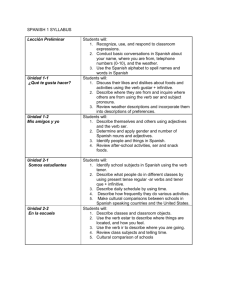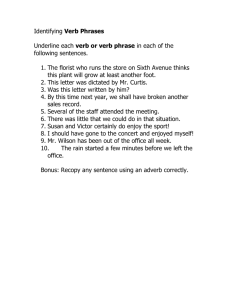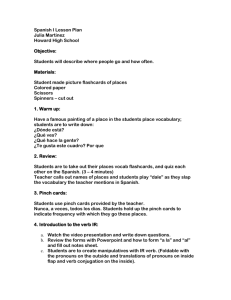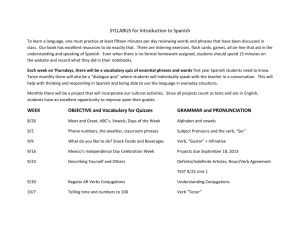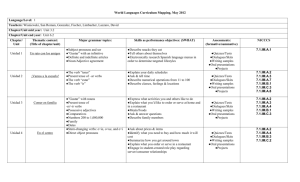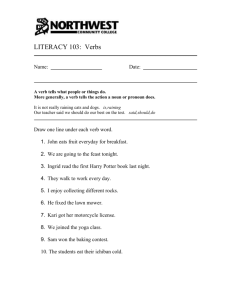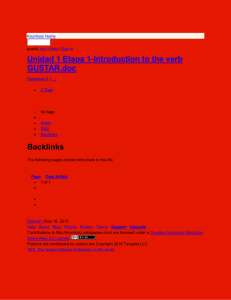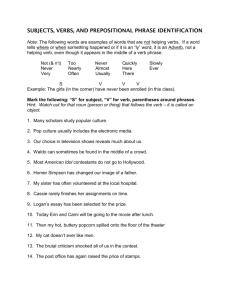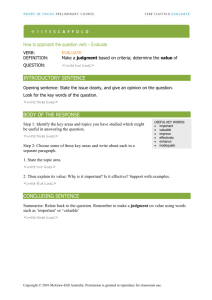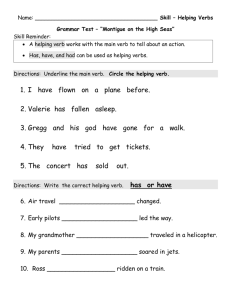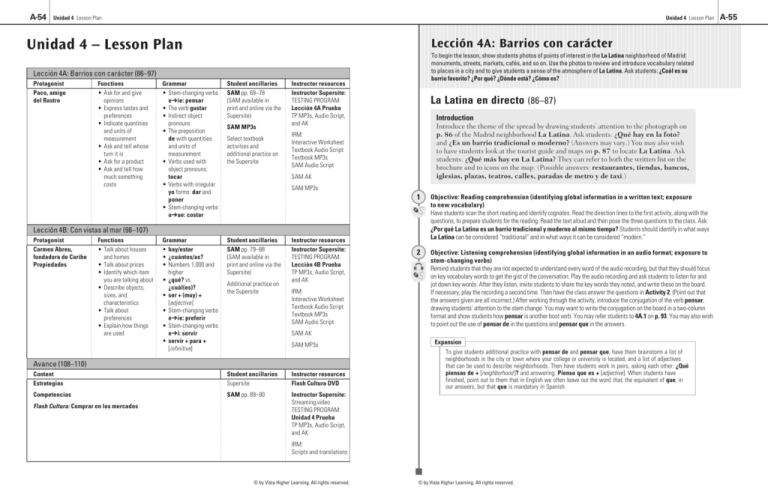
A-54
Unidad 4 Lesson Plan
Unidad 4 Lesson Plan
Unidad 4 – Lesson Plan
Lección 4A: Barrios con carácter
To begin the lesson, show students photos of points of interest in the La Latina neighborhood of Madrid:
monuments, streets, markets, cafés, and so on. Use the photos to review and introduce vocabulary related
to places in a city and to give students a sense of the atmosphere of La Latina. Ask students: ¿Cuál es su
barrio favorito? ¿Por qué? ¿Dónde está? ¿Cómo es?
Lección 4A: Barrios con carácter (86–97)
Protagonist
Paco, amigo
del Rastro
Functions
• Ask for and give
opinions
• Express tastes and
preferences
• Indicate quantities
and units of
measurement
• Ask and tell whose
turn it is
• Ask for a product
• Ask and tell how
much something
costs
Grammar
• Stem-changing verbs
e➔ie: pensar
• The verb gustar
• Indirect object
pronouns
• The preposition
de with quantities
and units of
measurement
• Verbs used with
object pronouns:
tocar
• Verbs with irregular
yo forms: dar and
poner
• Stem-changing verbs
o➔ue: costar
Student ancillaries
SAM pp. 69–78
(SAM available in
print and online via the
Supersite)
Grammar
• hay/estar
• ¿cuántos/as?
• Numbers 1,000 and
higher
• ¿qué? vs.
¿cuál(es)?
• ser + (muy) +
[adjective ]
• Stem-changing verbs
e➔ie: preferir
• Stem-changing verbs
e➔i: servir
• servir + para +
[infinitive]
Student ancillaries
SAM pp. 79–88
(SAM available in
print and online via the
Supersite)
SAM MP3s
Select textbook
activities and
additional practice on
the Supersite
Instructor resources
Instructor Supersite:
TESTING PROGRAM:
Lección 4A Prueba
TP MP3s, Audio Script,
and AK
La Latina en directo (86–87)
Introduction
Introduce the theme of the spread by drawing students’ attention to the photograph on
p. 86 of the Madrid neighborhood La Latina. Ask students: ¿Qué hay en la foto?
and ¿Es un barrio tradicional o moderno? (Answers may vary.) You may also wish
to have students look at the tourist guide and maps on p. 87 to locate La Latina. Ask
students: ¿Qué más hay en La Latina? They can refer to both the written list on the
brochure and to icons on the map. (Possible answers: restaurantes, tiendas, bancos,
iglesias, plazas, teatros, calles, paradas de metro y de taxi.)
IRM:
Interactive Worksheet
Textbook Audio Script
Textbook MP3s
SAM Audio Script
SAM AK
SAM MP3s
1
Objective: Reading comprehension (identifying global information in a written text; exposure
to new vocabulary)
Have students scan the short reading and identify cognates. Read the direction lines to the first activity, along with the
questions, to prepare students for the reading. Read the text aloud and then pose the three questions to the class. Ask:
¿Por qué La Latina es un barrio tradicional y moderno al mismo tiempo? Students should identify in what ways
La Latina can be considered “traditional” and in what ways it can be considered “modern.”
2
Objective: Listening comprehension (identifying global information in an audio format; exposure to
stem-changing verbs)
Remind students that they are not expected to understand every word of the audio recording, but that they should focus
on key vocabulary words to get the gist of the conversation. Play the audio recording and ask students to listen for and
jot down key words. After they listen, invite students to share the key words they noted, and write these on the board.
If necessary, play the recording a second time. Then have the class answer the questions in Activity 2. (Point out that
the answers given are all incorrect.) After working through the activity, introduce the conjugation of the verb pensar,
drawing students’ attention to the stem change. You may want to write the conjugation on the board in a two-column
format and show students how pensar is another boot verb. You may refer students to 4A.1 on p. 93. You may also wish
to point out the use of pensar de in the questions and pensar que in the answers.
Lección 4B: Con vistas al mar (98–107)
Protagonist
Carmen Abreu,
fundadora de Caribe
Propiedades
Functions
• Talk about houses
and homes
• Talk about prices
• Identify which item
you are talking about
• Describe objects,
sizes, and
characteristics
• Talk about
preferences
• Explain how things
are used
Additional practice on
the Supersite
Instructor resources
Instructor Supersite:
TESTING PROGRAM:
Lección 4B Prueba
TP MP3s, Audio Script,
and AK
IRM:
Interactive Worksheet
Textbook Audio Script
Textbook MP3s
SAM Audio Script
SAM AK
SAM MP3s
Avance (108–110)
Content
Estrategias
Student ancillaries
Supersite
Instructor resources
Flash Cultura DVD
Competencias
SAM pp. 89–90
Instructor Supersite:
Streaming video
TESTING PROGRAM:
Unidad 4 Prueba
TP MP3s, Audio Script,
and AK
Flash Cultura: Comprar en los mercados
Expansion
To give students additional practice with pensar de and pensar que, have them brainstorm a list of
neighborhoods in the city or town where your college or university is located, and a list of adjectives
that can be used to describe neighborhoods. Then have students work in pairs, asking each other: ¿Qué
piensas de + [neighborhood ]? and answering: Pienso que es + [adjective ]. When students have
finished, point out to them that in English we often leave out the word that, the equivalent of que, in
our answers, but that que is mandatory in Spanish.
IRM:
Scripts and translations
© by Vista Higher Learning. All rights reserved.
© by Vista Higher Learning. All rights reserved.
A-55
A-56
3
4
Unidad 4 Lesson Plan
Unidad 4 Lesson Plan
Objective: Reading comprehension (identifying discrete information in a written text; exposure to
the verb gustar)
Have students read (individually in silence or aloud in pairs) the opinions of some madrileños in Activity 3. Follow up
by asking which of the four people in the activity have a positive opinion of La Latina (Teresa, Lola, and Adrián) and
which have a negative opinion (Paloma): ¿Quién tiene una opinión positiva? ¿Quién tiene una opinión negativa?
Ask why Paloma has a negative opinion. If students do not understand the word antiguo, have them consider it as a
cognate and/or show pictures of old buildings in Madrid. Ask students their own opinions of historic buildings: ¿Te/Le
gustan los edificios antiguos/históricos? This activity serves as a preliminary model for the structure of sentences
with gustar. You may want to write on the board me gusta, te gusta, and so on, or solicit these from students. Then
write (a mí), (a ti), and so on in parentheses before each expression with gustar. Explain to students that the words in
parentheses are optional, and are used for emphasis or clarification. You may also refer students to 4A.2 on p. 93.
Objective: Expressing opinions and preferences orally and in writing
If you feel students need more exposure to relevant vocabulary, have them brainstorm a list of aspects of neighborhoods
like La Latina (edificios antiguos, mercados tradicionales, cafés modernos, etc.). Otherwise proceed directly to
Activity 4, having students first work individually to write sentences and then having them compare their opinions to
those of a classmate.
8
Objective: Vocabulary practice (food quantities and packaging)
Have students read the list on their own. They will quickly realize that the quantities/packages do not match the types of
products listed. Read, or have a volunteer read, the list aloud and have the group correct the list. Point out that there is more
than one correct possibility for each item and that either the packaging, the quantity, or the food item itself can be changed
to make a logical answer. Alternatively, you can have students work in pairs or call on individuals to make corrections.
9
Objective: Reading for discrete information and controlled speaking practice
Students will read the two sections and relate individual lines of dialogue to steps in the interaction. You may also
refer students to 4A.3 and 4A.4 on p. 94, 4A.5 on p. 95, and 4A.6 on p. 96. When they have understood the interaction,
let students role-play the conversation with these or other products. (Recommended: have students role-play the
dialogue as-is the first time through, and then create new dialogues with different products.) You may wish to take this
opportunity to have the class practice the pronunciation of words that may cause difficulty (ahora, botella, docena,
huevos). You may also wish to invite volunteers to perform their dialogues for the class. If so, have listeners write down
the food purchases and quantities mentioned so that they remain engaged while their classmates are performing.
10
Objective: Oral and written expression (food prices, quantities, and packaging)
Have students make the calculations asked for in Activity 10.
Expansion
Expansion
As an optional additional activity to practice all the pronouns with gustar, distribute blank red and
green paper to students (a quarter-sheet per student). Have students write positive aspects of a
neighborhood (nouns and adjectives) on green sheets and negative aspects on red sheets. When they
are ready, have students hold up their cards so the whole class can read them, and then have the class
compose sentences: A María le gustan los edificios antiguos. A Peter y a mí nos gustan los
bares, etc. Write the sentences on the board to reinforce this somewhat complex sentence structure.
5
As a follow-up, ask questions about students’ personal food preferences. For example: ¿Quiénes en la
clase no comen salchichas? ¿Por qué no? ¿Son vegetarianos? ¿Quiénes no beben leche? ¿A
quiénes les gustan mucho los tomates? ¿A quiénes no les gustan para nada? etc.
11
Objective: Interactive speaking practice (talking about your surroundings)
Have students read the Guión de trabajo and ask one another about their neighborhoods, speaking with as many
different classmates as time permits. Because many students may live on or near campus, you can as an alternative have
them talk about their hometowns.
Objective: Interactive speaking practice (grocery shopping)
Review the conversation in Activity 9 with students; then divide them into groups to complete the activity.
Expansion
An optional follow-up activity is to conduct a survey of the class to see where the majority buy their
groceries. Write the names of the major grocery chains, small local stores, open-air markets, and other
possibilities on the board and then tally the results. (Remember that students living in dorms may not do
any grocery shopping during the school year.) Other follow-up activities could be to simply find out what
percentage of the class enjoys grocery shopping and what percentage does not.
Hacer las compras (88–89)
Introduction
Paco, amigo del Rastro (90–91)
This spread introduces not only some food-related vocabulary, but also two cultural contexts:
shopping in small, locally-owned stores and shopping in supermarkets. Introduce the theme
of the spread by having students look at the photos on p. 88. Ask students to describe the
two shoppers: ¿Cómo son estas personas? ¿Dónde les gusta hacer las compras? Note
that they are of different sexes and ages, and probably have a different relationship to their
neighborhood. Ask students: ¿Qué tienda es más tradicional? ¿Cómo es una tienda
típica de este país? ¿Qué tipo de tienda te gusta? ¿Por qué?
Introduction
Paco Suárez García has a booth in the Rastro of Madrid, a place emblematic of this
multicultural city. Paco represents one face of the Rastro, and he knows the area well.
Through him, students will become familiar with open-air markets and shopping habits
in Spain.
6
Objective: Oral expression based on a visual prompt
Go over the units of measurement presented in the sidebar. Point out that in the Spanish-speaking world, measurements are
usually metric, and that a kilogram is equivalent to 2.2 lbs. Ask students to name other products they typically purchase in
these quantities. Then have students answer the questions in Activity 6. You may also refer students to 4A.3 on p. 94.
12
Objective: Reading and listening comprehension (reading for global information)
Have students look over the photo of Paco and the information that accompanies it below, and ask them to formulate
questions they might ask about Paco, such as: ¿Cómo se llama el señor de la foto? Play the audio recording for Paco,
amigo del Rastro and then do Activity 12 together as a class.
7
Objective: Listening for discrete information (food quantities and packaging)
Play the audio recording and have students jot down the products and the quantities that they can identify. Have
students compare their answers as a class and then play the recording a second time.
13
Objective: Reading comprehension (reading for discrete information)
Have students fill in the information sheet individually or in pairs and then go through the sheet together as a class.
© by Vista Higher Learning. All rights reserved.
© by Vista Higher Learning. All rights reserved.
A-57
A-58
14
15
Unidad 4 Lesson Plan
Unidad 4 Lesson Plan
Objective: Oral expression based on written prompts
By now, students have learned a good deal of information about Paco and should be able to conduct a brief, open-ended
conversation about him. If students get stuck, you can give them some sentence starters like El señor se llama… Vive
en… Tiene… Trabaja… Le gusta… Write these sentence starters on the board as references while students work
in pairs.
Objective: Oral expression
This activity may require you to provide some new vocabulary to students. Have the class brainstorm a list of items
representative of their region that they could sell at a market, and write these items on the board, providing the Spanish
terms whenever students cannot produce them.
Yo puedo...
Have students complete the Yo puedo activities and reflect on their success in carrying out each task. For the first and
last tasks, have students brainstorm and draw a “mind map” on the board showing their ideas, which they can draw
upon for these written and conversational tasks. Suggest to students that they write their grocery shopping lists in
Spanish from now on, to continuously practice the food vocabulary that they most need.
Gramática funcional (93–96)
4 A .1 You may wish to introduce the stem-changing pensar and the uses of que and de after pensar, and have students
practice them separately before they are put together in G1 and G2.
Opinión
The questions in the Opinión box may serve for a whole-class, small-group, or pair discussion.
Encourage students to share opinions about their shopping habits as expansively as they can.
16
Objective: Reading comprehension (reading for discrete information)
Read aloud the article about the Feria de San Telmo and have students work in pairs to fill in the notes below. Then go
through the notes as a class.
Expansion
As an expansion activity, have students write their own ficha like the one they filled out about the
Feria de San Telmo, based on a market in their hometown or another market. Students may need to
do research online to gather all the data they need.
17
18
Objective: Pronunciation practice
Introduce the sounds /r/ and /rr/ and let students listen to you enunciating words with both sounds so that they can
begin to hear the difference. Then play the audio recording and have students identify the letters. Point out to students
that the single r at the beginning of a word is pronounced as an /rr/. Finally, have students practice pronouncing the
neighborhood names in part b.
Objective: Reading comprehension (reading for both global and discrete information)
This short reading about open-air markets in Cuba allows students to compare and contrast grocery shopping
experiences in Spain, Cuba, and their own home regions. Students will also see that the names for foods vary between
one Spanish-speaking country and another. You may want to ask students to identify specific similarities and differences
between the markets. For example, there are traditional markets in both Spain and Cuba, but the photos suggest that
in Spain they are favored by more traditional shoppers—young Spanish men, for example, might prefer to shop in
supermarkets—while in Cuba they are frequented by all shoppers. North America has farmers’ markets, but they are
not places where shoppers go to learn about current events. Produce in all three countries varies a great deal according
to the climate. Ask: ¿Son parecidos los mercados o son diferentes? ¿Quién hace las compras en estos
mercados? ¿Hay mercados similares en este país?
Tarea final
The verb gustar often causes difficulties for speakers of English. Emphasize that gustar literally means not to
like but to please or to be pleasing to. Write sentences on the board and draw an arrow from the subject to the verb
to show that a singular subject (barrio, in the first example) takes a singular verb form (gusta). Give students many
example sentences, using different combinations of singular and plural subjects and verbs, so they can begin to master
the pattern. Beginning students can learn to use gustar correctly in highly-controlled settings, but do not expect them to
always use it correctly in open-ended conversation and writing where their focus is on content.
4 A .2
This section also introduces both the indirect object pronouns used with gustar and the pronouns after the preposition
a that are used with gustar. You may wish to introduce these topics separately before asking students to use them
together in G3 and G4.
4 A .3 Students are not likely to have difficulty expressing quantities and units of measurement except perhaps with medio
kilo and media docena. Write medio/a = ½ on the board. Ask students: Si un kilo es 1000 gramos, ¿entonces
medio kilo es…? (500 gramos) Si una docena es doce, ¿media docena es…? (seis) Point out that in Spanish we
use the article with docena and kilo but not with medio/a.
4 A .4 The verb tocar is used with indirect object pronouns to state whose turn it is. Tocar in this context functions like
gustar. It may help students to know that me toca literally means it touches me. (The word “it” refers to a turn.) Tell
students that, as with the verb gustar, the pronouns after the preposition a are used for emphasis or clarification, and
are optional.
Dar and poner are two common verbs with irregular yo forms that are used in shopping. In addition to emphasizing
the irregular forms of these verbs, tell students that the use of dar and poner in this context is an excellent example of
how Spanish is not simply a direct, literal translation of English. If they translate the expressions in 4A.5 directly into
English, students will end up with expressions we would not use in English, and vice versa.
4 A .5
Point out that the indirect object pronouns used with dar and poner in this context are the same pronouns the students
have been studying with gustar and tocar.
4 A .6 Costar is another stem-changing verb. Like all stem-changing verbs, costar is a “boot verb,” but the stem change
is different from that of pensar; here, the change is from o to ue, as with almorzar. Tell students that in future lessons
they will encounter other stem-changing verbs from these two “families” of verbs and from other families, and that they
will get used to the symbol showing a vowel, an arrow, and one or two more vowels representing the stem change.
All ¡Póngalo en práctica! activities are available on the Supersite.
Objective: Oral interaction
Before beginning this activity, review with students the expressions for buying and selling that they have learned in
this lesson. You may wish to have students prepare a list of items they will “sell,” along with pictures, before class.
Emphasize that students should use vocabulary they and their peers have already learned; they should not “sell” items
whose names they have not studied, as the purpose of this activity is to practice what students have already learned.
Alternatively, you can provide the items yourself (whether they be pictures or words on cards, or perhaps actual items).
In pairs or small groups, students will work together to assign prices to the items. Some individuals in the group will then
go “shopping,” while others stay in their seats and become “vendors.” At the end of the activity, shoppers should return
to their original groups and show what they have bought, telling their classmates how much each item cost. This game
can be played twice so that each student has an opportunity to both buy and sell.
© by Vista Higher Learning. All rights reserved.
Vocabulario (97)
Depending on your class schedule, teaching style, and assessment preferences, you may wish to identify for
students certain high-frequency, “core” vocabulary items that you expect them to focus on when preparing for
tests and exams. To aid students in personalizing and retaining new vocabulary, encourage them to create a
personalized dictionary, in which they record the words from the lesson that they consider most useful, as well
as any related expressions they have learned in conjunction with this lesson.
© by Vista Higher Learning. All rights reserved.
A-59
A-60
Unidad 4 Lesson Plan
Unidad 4 Lesson Plan
Lección 4B: Con vistas al mar
4
Objective: Practicing new vocabulary; listening comprehension; exposure to new
grammatical constructions
Have students do part a of this activity as a class.
Continue with part b of the activity. Play the audio recording and have students fill in the blanks with qué or cuál.
Follow up with a brief explanation of the difference between the two. You might write qué, cuál = what on the board
and then write qué + [noun], cuál + [verb], pointing out that the sentences in the audio activity follow this model. You
may also refer students to 4B.3 on p. 105.
In part c of the activity, play the recording again, asking students to write down as many details about each rental as
they can. As a follow-up, ask individuals to share their responses with the class.
5
Objective: Written expression (housing)
Let students work individually and be available to assist them. Then have them work with a partner to answer the
questions in Activity 5.
6
Objective: Interactive speaking practice (housing)
Allow students a moment to think about and take notes on, or even draw, their dream houses. Then have them interview
each other. Finally, ask volunteers to share with the class what they have learned about their partners’ ideal homes.
Ask the class if any partners have unusual dream houses, and ask them to describe them: ¿Cómo es la casa de su
compañero/a? ¿Es típica o inusual? Descríbala.
To begin the lesson, show students ads from Spanish-speaking countries for real estate rentals and sales,
and/or pictures and floor plans of typical houses. Ask students about their current homes or, if they live in
dormitories, about the homes they grew up in: ¿Es un apartamento o una casa? ¿Cuántos dormitorios tiene?
¿Cuántos baños tiene? ¿Tiene piscina? In the second spread, you can show furniture catalogues to allow
students to practice lesson vocabulary.
Apartamento de alquiler (98–99)
Introduction
The theme of the spread is presented through an ad for vacation rentals. The floor
plan will help students put new vocabulary and structures to use, while the photos
will orient students to the theme of vacations and tourism. Introduce the theme of the
spread by drawing students’ attention to the photo. Ask: ¿Dónde están estas casas?
¿Es bonito el lugar? ¿Es un buen lugar para vacaciones?
1
Objective: Reading comprehension (identifying discrete information based on a visual prompt;
gaining exposure to new vocabulary)
If you have not already presented the rooms of a living space, go over this vocabulary using the sidebar on p. 98. Then
have students examine the floor plan in Activity 1 and identify the rooms.
Expansion
Have groups of students imagine the dream home of the protagonistas in Units 1 to 3.
Expansion
As an optional follow-up activity, have students draw a floor plan of their apartment or home, labeling
the rooms with the vocabulary they have just learned. They should also make a list of nearby amenities
(supermercado, parque, piscina, playa, etc.). Then have students go around the class and find
someone with whom they share four items on their floor plan and list of amenities. Have students use
the function in sidebar 4B.1 as a script.
2
3
Objective: Oral expression (vocabulary and grammatical structures relating to housing)
Ask questions based on the ads using the verbs tener, estar, and haber and the interrogative cuántos/as: ¿Cuántos
dormitorios tiene? ¿Dónde está? etc. You may also refer students to 4B.1 on p. 105. Ask students to guess the
meanings of the cognates terraza, jardín, garaje. Ask them if they can deduce, based on context, what bien
comunicado must mean. Then pair students to complete part a of this activity.
Before proceeding to part b, clarify puede alquilar if necessary. Have students work in pairs and then share their
answers with the class.
Objective: Gaining exposure to and practicing numbers over 1000
Present the numbers 1000 and higher on the board and allow students to practice them in a variety of combinations; for
example, counting by 1000s or by 10,000s both forwards and backwards, and reading aloud various numbers you write
on the board. When students are comfortable with these large numbers, have them do Activity 3. You may also draw
students’ attention to 4B.2 on p. 105.
Expansion
As an optional follow-up activity, bring in ads for real estate in different Latin American countries and
have students find apartment/home prices in a certain price range: Busquen casas o apartamentos
entre 250 000 y 500 000 pesos.
© by Vista Higher Learning. All rights reserved.
Su casa, su estilo (100–101)
Introduction
This spread introduces home furnishings through a furniture catalogue and an ad for
household appliances.
7
Objective: Gaining exposure to and practicing new vocabulary
Read aloud the names of the pieces of furniture presented so students can hear and practice their pronunciation. Then have
students work in pairs to complete Activity 7.
8
Objective: Written expression (describing objects in writing)
Draw students’ attention to the sidebar on p. 100, in which descriptors are presented. Have students identify cognates
and clarify for them the less obvious expressions sencillo, de diseño, and the question ¿Cómo es? To allow students
additional practice, you might show photos of various home furnishings and ask the class to describe them aloud. (This
is also a good opportunity to review colors with students.) Then have students work individually to write sentences in
Activity 8. Finally, follow up by asking volunteers to share their sentences with the class.
Expansion
Give students pages of a furniture catalogue and have them describe what they see in the photos
and read the prices aloud. For example: Esta silla es cómoda y moderna. El precio de la silla es
treinta y cinco dólares.
© by Vista Higher Learning. All rights reserved.
A-61
A-62
9
Unidad 4 Lesson Plan
Unidad 4 Lesson Plan
Carmen Abreu, fundadora de Caribe Propiedades (102–103)
Objective: Listening comprehension (identifying discrete information in an audio recording)
Read the instructions and the four sentences aloud to students to prepare them to listen to the audio recording. Have
students guess the meaning of prefiere and prefieren. The verb preferir will be practiced in detail in Activity 10.
Then play the recording and have students mark the statements in part a of the activity as true or false. Go through the
answers as a class afterward.
For part b, play the recording again and ask students to answer the question.
10
Objective: Expressing individual preferences
Before having students do Activity 10, review the verb preferir. Draw students’ attention to the stem change. You
might introduce only the first and second-person singular forms, since these are the only forms that are needed to
complete the activity. As a follow-up to Activity 10, you can present the rest of the conjugation. You might also direct
students to 4B.5 on p. 106 and to the function sidebar Hablar de preferencias on p. 100.
11
Objective: Oral expression (stating the uses of objects)
Use the ad at the top of p. 101 and the function sidebar Expresar utilidad to introduce the expression sirve para. Have
students do Activity 11 as a class.
Introduction
In this spread, students meet a protagonist who has turned her personal travel
preferences into a career. The founder of a specialized real estate agency, she locates
vacation apartment rentals for tourists in the Caribbean, because she herself prefers
to stay in an apartment rather than in a hotel when she travels. Introduce the theme of
the spread by asking students where they prefer to stay when they travel: ¿Prefieren
pasar las vacaciones en un hotel o en un apartamento? ¿O prefieren un hostal o
albergue? ¿Prefieren pasar las vacaciones solos, con amigos o con la familia?
15
Objective: Reading comprehension (identifying discrete information on a map)
Introduce the reading by drawing students’ attention to the photos and map. Clarify the words propiedades and
inmobiliaria. Then have the class do Activity 15.
16
Objective: Reading comprehension (identifying discrete information in a written text)
Have students do Activity 16 as a class.
17
Objective: Reading comprehension (identifying global information in a written text)
Have students read through the vocabulary list on p. 102 before you read the text aloud to the class. Then have students
do Activity 17 as a class.
18
Objective: Reading comprehension (identifying discrete information in a written text; expressing
personal preferences)
Have students work individually to carry out the task in Activity 18. Then ask volunteers to share their findings with
the class. Finally, ask students if they share Carmen Abreu’s perspective on travel lodgings: ¿Están de acuerdo con
Carmen Abreu? ¿Por qué?
19
Objective: Brief written expression
Have students work individually to fill out the form based on their own personal preferences and information. Ask
students to review and draw on as much of the lesson vocabulary as possible; then ask them to share their work in
small groups.
Expansion
As an expansion activity, have students play a game of 20 Questions. One volunteer thinks of a
piece of household furniture and the others must ask yes-or-no questions to guess what it is.
Questions include: ¿Está en el salón? ¿Está en el dormitorio? ¿Sirve para cocinar? ¿Sirve
para leer? etc.
12
Objective: Gaining exposure to the verb servir
Draw students’ attention to the conjugation of the verb servir, pointing out the stem change. You may also refer
students to 4B.6 on p. 106. Then have students work individually to complete Activity 12.
You may want to write the conjugations of preferir and servir on poster board, showing stem changes in a different
color, and post these on the classroom wall as a visual reference.
13
Objective: Written expression (describing objects in writing)
Model the activity by describing another object; for example, write: Es de tamaño mediano. A veces es bonita, a
veces no. Está en muchas habitaciones de la casa. Sirve para iluminar la habitación por la noche. Have
students guess what the object is (answer: la lámpara). Have students write their own sentences and play the guessing
game with a partner. Remind students to describe both the object itself and its function.
14
Objective: Controlled speaking practice (personal preferences in housing)
Walk students through the Guión de trabajo before having them work in pairs to describe their personal styles.
Students may choose to describe their current dorm rooms or apartments, the homes they grew up in, or their imagined
future home.
© by Vista Higher Learning. All rights reserved.
Expansion
Turn Activity 19 into an oral activity in which pairs of students role-play a conversation between
Carmen and a client. The student playing the client can use the form in Activity 19 to prepare for the
conversation. The student playing Carmen can use the form to take notes.
20
Objective: Reading comprehension (identifying global information in a written text); interactive
oral expression
Have students read through the vocabulary in the sidebar on p. 103. To practice this vocabulary before reading the text,
ask students to sort vocabulary items into categories: el turismo, el mundo natural, and el dinero. Then read the text
aloud and have students choose the best headlines for each paragraph to complete the activity in part a.
Continue with part b of the activity by having students work in pairs or as a whole class.
For part c, have students work in groups to express their perspectives. As a follow-up, you can take a poll to see
how many students are in favor of the ecotasa, and how many are opposed. Call on a few volunteers to explain
their positions.
© by Vista Higher Learning. All rights reserved.
A-63
A-64
21
22
Unidad 4 Lesson Plan
Unidad 4 Lesson Plan
Objective: Pronunciation practice
Point out to students that the /k/ sound can be represented in three different ways. Then play the audio recording and
have students fill in the table. Afterward, go over the rules governing the uses of these consonants as presented in
Activity 21.
Objective: Exposure to lexical variation
Encourage students to use cognates and context to work out the meanings of words in the ads that are new to them.
Vocabulario (107)
Depending on your class schedule, teaching style, and assessment preferences, you may wish to identify for
students certain high-frequency, “core” vocabulary items that you expect them to focus on when preparing for
tests and exams. To aid students in personalizing and retaining new vocabulary, encourage them to create a
personalized dictionary, in which they record the words from the lesson that they consider most useful, as well
as any related expressions they have learned in conjunction with this lesson.
Tarea final
Objective: Written and oral expression on housing
Before beginning this activity, brainstorm with students a list of all the aspects of housing that they might want to
include in a description: its size, appearance, furnishings, number of rooms, location in the city, nearby attractions, price,
and perhaps other features. Have students work individually to write their descriptions, and be available to assist them.
Students will then discuss in pairs and each pair will choose one of the two descriptions to share with the class. Tell
students they should choose whichever house seems more likely to attract a renter. Also remind students to carry out
their pair work entirely in Spanish. The pairs will then share their descriptions with the whole class, and finally, each
individual should jot down his or her favorite exchange destination. As a final activity, tally up how many “votes” each
destination receives.
A variation on this activity is to have students insert a “trick” into each description, such as having an apartment on
the eighth floor with no elevator, or a house with a freeway view. When listening to descriptions, students should be
listening for these “tricks” and can decide together which is the worst house on offer.
Yo puedo…
Have students complete the Yo puedo activities and reflect on their success in carrying out each task. After students
have had time to complete the page, ask volunteers to share their responses to the questions where answers are written
in boxes.
Gramática funcional (105–106)
4 B .1 Students often confuse the use of hay and estar when talking about where things are located. Point out that está/
están = it is/they are whereas hay = there is/there are.
The numbers 1000–9000 may cause students some difficulty because of irregularities. Beyond 9000 there are no
irregularities and students will struggle only if they have insufficient practice using large numbers. You may wish to open
each class period with counting and number practice for a few days, and incorporate contextualized number practice
wherever possible from now on.
4 B .2
4 B .3 Students are often confused by the use of qué vs. cuál(es). A good place to begin is simply to establish the pattern
qué + [noun], cuál(es) + [verb]. Subtle variations (for example, qué + es to ask for a definition, qué + te + gusta) can be
addressed as they arise later.
4 B .4 Students will probably not struggle with the basic structure of this simple sentence and its variations for describing
objects, though they sometimes misplace the word no in negative sentences and confuse muy with mucho. Some
mechanical practice with visual prompts may help students sort out these issues.
4 B .5
Careful pronunciation and spelling practice can help students master the stem change in preferir.
4 B .6 Although the complete conjugation of the stem-changing verb servir is presented here, you should emphasize the
third-person singular and plural forms, as those are the forms that have a practical application in this lesson.
All ¡Póngalo en práctica! activities are available on the Supersite.
© by Vista Higher Learning. All rights reserved.
© by Vista Higher Learning. All rights reserved.
A-65
A-66
Unidad 4 Lesson Plan
Unidad 4 Lesson Plan
4
AVANCE
Estrategias (108)
1
Expansion
Objective: Reinforce language study outside of class
It is important for students to consider and share with one another how they can continually reinforce and enrich their
language-learning outside of class. Give students time to read the list presented in Activity 1 and then ask them for
suggestions on where to find these resources. Students are often aware of good websites, video stores with good
foreign-language selections, places in town to get a Spanish-language newspaper, and so on. Ask students to share
strategies that they have already found for using these resources. Even beginning learners can benefit from exposure to
Spanish-language radio or television, for instance. They might give themselves a simple task like picking out numbers,
greetings, or colors in spoken ads. Encourage students to search the Internet for lyrics to Spanish-language songs they
like, and to watch movies in Spanish with English subtitles.
2
Objective: Use visual associations to reinforce vocabulary
A visual association is a much more effective vocabulary-learning tool than a Spanish-to-English translation. Students
need not be artistically inclined to make images: stick figures and symbols can be equally effective. Some students may
enjoy making flashcards with magazine pictures or clip art from the Internet.
3
Objective: Practice asking for clarification
Have students search for the two expressions in Lección 4A, and then ask them other ways they know of to request
repetition. You may wish to have students practice this strategy by pronouncing some statements very quickly or with
unclear diction, prompting them to ask for clarification or repetition.
4
Objective: Practicing irregular verb conjugations
Have students fill in the chart individually and then compare their answers to those of a classmate, or review the chart
as a class.
Objective: Practice paraphrasing
Paraphrasing is a critical speaking skill that students will probably continue to employ for the rest of their Spanishspeaking lives. Have students describe the objects in Activity 4 together as a class, and then, if possible, provide
pictures of additional objects and let them describe them in pairs (have students keep their pictures hidden from their
partners, so partners must rely on the descriptions to guess the object).
Competencias (109)
To provide additional practice, create a set of cards with the infinitives of several verbs students are
familiar with. Divide students into groups and provide each group with a stack of infinitives and a
playing die. Each student takes a turn drawing a card, then rolling the die and conjugating the verb
according to the side the die lands on (one spot = yo; two spots = tú, etc.).
Flash Cultura (110)
Comprar en los mercados
1
Read the Using visual cues strategy on p. 110 aloud to the class and then show the video stills, eliciting ideas from the class
about the theme of the video. Then read the introduction and divide students into pairs or groups to discuss their experiences.
As a follow-up, solicit ideas for bargaining vocabulary and expressions. Most students who have lived in urban areas will
have had the experience of shopping in an open-air market. Discuss with students the cultural difference that for most North
Americans, open-air food markets are a kind of specialty market and constitute a fun, somewhat unusual excursion for
shoppers, whereas in Spain and Latin America a trip to an open-air market is an everyday occurrence, as ordinary for those
shoppers as a trip to a supermarket or convenience store is here.
2
Before showing the video, have students read through the Vocabulario útil at the left. Look over the three pictures and read
the captions so students can anticipate the content of the video episode. Show the video, reminding students to pay attention
to the on-screen labels.
3
Ask volunteers to read aloud the two descriptions that appear in Activity 3 and have the class select the description that best
matches the video episode.
4
Read aloud the Making polite requests strategy. Then have students work in pairs to prepare the dialogue in Activity 4. Ask
volunteers to perform their dialogues for the class.
The activities in the Competencias section recycle topics studied in previous lessons and allow students to refresh their
skills and ensure that they can still carry out key tasks.
1
Objective: Oral interaction (expressing frequency of work and leisure activities)
One student should use agenda A and the other agenda B. They should keep their own sheets hidden from the other
and take turns asking and answering questions until they arrive at days and times for the suggested activities that will
work for both their schedules.
2
Objective: Categorizing vocabulary items
Have students sort the items listed on the right into the categories pictured at the left. If necessary, review with students
the meanings of the words hogar and alimentación. This activity can be done in pairs, in small groups, or as a whole
class, depending on how much time you can allot to it and how much individual practice your students need.
3
Objective: Oral expression of descriptions, comparisons, and preferences
You may wish to introduce this activity by modeling questions such as ¿Qué teléfono te gusta más? ¿Cuál cuesta
más? and responses such as me gusta más la exótica and la clásica cuesta más. Alternatively, you may choose
to bring in photos of additional items, asking and answering questions of the whole class before putting them in pairs to
complete Activity 3.
© by Vista Higher Learning. All rights reserved.
© by Vista Higher Learning. All rights reserved.
A-67
A-68
Unidad 4 Lesson Plan
Unidad 4 Lesson Plan
A-69
Suggestions for pacing and use of ancillary materials
Ancillaries and homework
Your use of the textbook and the ancillaries depends on your course configuration, your students’ needs, and your own teaching style.
You may wish to ask students to prepare vocabulary and grammar for a lesson or a portion of a lesson before coming to class in order to
maximize interactive time in the classroom and allow students to practice what they have already studied. Alternatively, you may wish to
introduce students to new vocabulary and grammar yourself inductively, allowing students to experience new material in context before
taking it home to process it. Finally, you may prefer to present new material to students through direct teaching, placing greater emphasis
during class time on the Gramática funcional sections.
To assist you in assigning homework, whichever your approach, you will find mapped below the sections of the Student Activities Manual
and the Supersite that correspond to each of the Unit 4 sections.
Student textbook section
Student Activities Manual
sections
Supersite
4A spread 1: La Latina en directo
pp. 69–71
Textbook activities with mouse icon
Pacing
4A spread 2: Hacer las compras
pp. 72–74
Audio-based textbook activities
The following is a suggestion for teaching Unit 4 in a variety of course configurations. This chart assumes a total of 120–135 classroom
hours over the course of a school year in either a trimester or semester program.
4A Protagonista: Paco, amigo del
Rastro
pp. 75–77
Additional practice activities
Practice more at vhlcentral.com.
4A Tarea final/Yo puedo…
p. 78
4A Gramática funcional
La Latina en directo: pp. 69–71
¡Póngalo en práctica! activities
Hacer las compras: pp. 73–74
Additional practice activities
Practice more at vhlcentral.com.
Number of
days/week
class meets
two 2-hour
classes
three 1-hour
classes
four 1-hour
classes
five 1-hour
classes
Week 1, Day 1
Week 1, Day 2
Week 1, Day 3
Week 1, Day 4
Week 1, Day 5
Week 2, Day 1
Lesson 4A
Quick review;
Lesson 4B
n/a
n/a
n/a
Assessment
Lesson 4A
spreads 1, 2,
and 3
Quick review;
Lesson 4A
Tarea final/
Yo puedo
and Lesson 4B
spreads 1 and 2
Lesson 4B
spread 3 and
Tarea final/
Yo puedo;
Lesson review
n/a
n/a
Assessment
Lesson 4A
spreads 1, 2,
and 3
Lesson 4A
spreads 1 and 2
Quick review;
Lesson 4A
Tarea final/
Yo puedo
and Lesson 4B
spreads 1 and 2
Lesson 4A
spread 3 and
Tarea final/
Yo puedo
Lesson 4B
spread 3 and
Tarea final/
Yo puedo;
Lesson review
Lesson 4B
spreads 1 and 2
Assessment
Lesson 4B
spread 3 and
Tarea final/
Yo puedo
Textbook vocabulary audio
4B spread 1: Apartamento de alquiler
pp. 79–81
Textbook activities with mouse icon
4B spread 2: Su casa, su estilo
pp. 82–84
Audio-based textbook activities
4B Protagonista: Carmen Abreu,
fundadora de Caribe Propiedades
pp. 85–87
Additional practice activities
Practice more at vhlcentral.com.
4B Tarea final/Yo puedo…
p. 88
4B Gramática funcional
Apartamento de alquiler: pp. 79–81
¡Póngalo en práctica! activities
Su casa, su estilo: pp. 83–84
Additional practice activities
Practice more at vhlcentral.com.
Unit 4 Prueba
Textbook vocabulary audio
Avance
Autoevaluación, pp. 89–90
Flash Cultura video
Flash Cultura comprehension activity
Additional practice activities
Practice more at vhlcentral.com.
© by Vista Higher Learning. All rights reserved.
© by Vista Higher Learning. All rights reserved.

